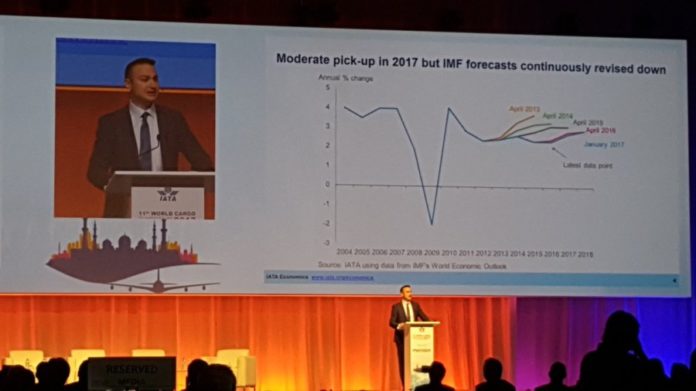

The economic outlook is bright for air cargo as demand is rising, but there are various headwinds set to impact air cargo, delegates at IATA’s World Cargo Symposium heard today.
IATA’s senior economist, George Anjaparidze told delegates growth in air cargo in 2017 is set to be about the same as in 2016 when freight tonne kilometres grew by 3.8 per cent. “In 2017, there has been a good start and the tailwinds are strong – export orders are strong and consumer confidence is high,” he says.
He explains the macro economy is strong, but there are concerns such as world trade which is still sluggish, despite air cargo punching above this rate, while rising capacity and increasing fuel prices are risks. “Yields have been stable but rising capacity and rising fuel prices will put the profitability outlook under strain,” Anjaparidze says.
He adds overcapacity was due to widebody bellyhold aircraft deliveries flooding the marketplace. “This is contributing to overcapacity on some trade lanes but not all trade lanes, but it is not an issue of the transpacific. However a lot of the newly added widebody capacity is being deployed on the Asia-Europe trade lane,” Anjaparidze adds.
“Capacity increases have made it hard for yields to keep up with fuel prices and if this persists we can see how the profitability outlook will come under further strain.”
Structural factors boosted air cargo as firms are becoming more reliant on product launches such as Apple with the iPhone, which needs air to meet the demand of e-commerce and immediate consumer needs.
Cyclical factors are also having an influence such as the broadening of sectors in Europe, such as perishables and high value goods, which are dependent on air cargo. He said one reason why air cargo had outperformed world trade was the speed of growth in the Eurozone was so good.
He also notes in 2016, that Europe and Asia made up 64 per cent of the growth, North America 11 per cent and the Middle East 24 per cent.
In 2017, Anjaparidze says upside influences include the US economy stimulus, normal inflation and broad growth, while the downside factors are Brexit and EU elections, capital flight from EM and trade wars.
He believes risks exist but the outlook is tilting to the upside in 2017: “The upside risks have a high probability so that gives us room for cautious optimism. If the downside risk materialise governments are not well positioned to cope.
“Our expectations are for air cargo to perform in 2017 comparable to 2016 rates with moderate growth.”









